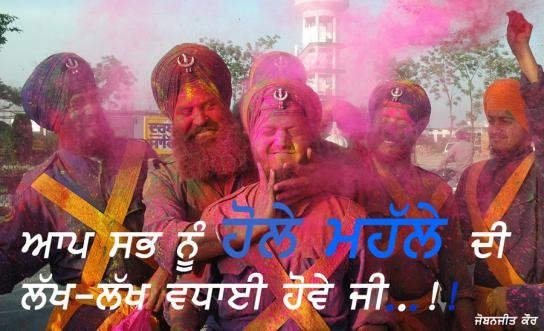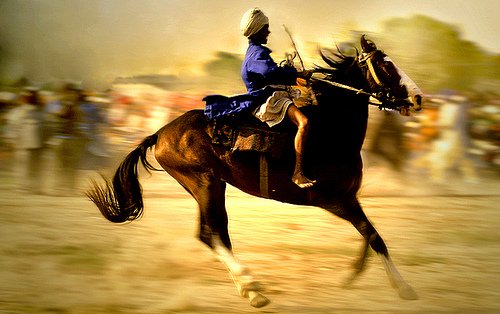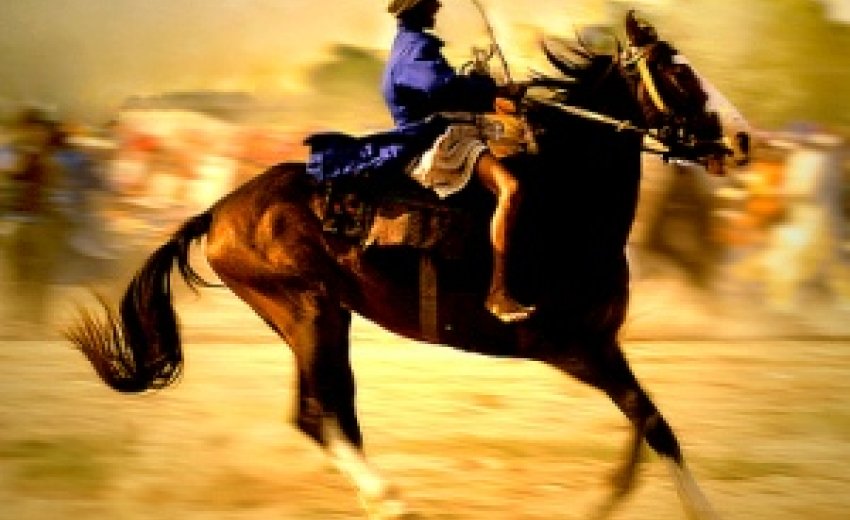
With shining swords, long spears, conical turbans and twirled-up moustaches, Nihangs gallop past on frothing horses, raising clouds of dust, as they celebrate Hola Mohalla every March in Punjab.
Coinciding with Holi, the festival of colour, it reminds the people about the tradition of meaningful festivity, and displays the valour inculcated in the Sikh community by Guru Gobind Singh, who took to armed struggle against tyranny.
The foothills of the Shivaliks in Ropar district of Punjab's north-eastern region, especially around the historic townships of Anandpur Sahib and Kiratpur Sahib, have, since 1701, been playing host to Hola Mohalla. Recently, the Indian government accorded it the status of a national festival.
During the festival, a sea of humanity descends on these towns, which are currently preparing for the mega celebration of the 300th anniversary of the Khalsa order.
Guru Gobind Singh rechristened the Holi festival by the end of the 17th century as Hola Mohalla, to use the opportunity to train his forces in the art of warfare. Near the fort of Holgarh in Anandpur Sahib, his headquarters, the Nihangs, as the Sikh warriors were called, divided into two groups and engaged in mock battle.
The military exercise, which was personally supervised by the guru, was carried out on the bed of the River Charan Ganga with the famous Hindu temple of Mata Naina Devi in the Shivaliks as the backdrop.
Faced with the might of the Mughal empire, the guru felt the need to create a typical martial vocabulary, differentiating it from the local dialect, to ensure the permanence of chardikala (high spirits) among his men.
Several words that were then considered weak were tampered with to give them a male gender and make them sound more militant. Thus, Holi became Hola. Similarly, the katar (cutlass) became katara, teg (sword) changed to tega, and barchhi (lance) to barchha. Certain other words were also changed to deceive the enemy spies -- chane (grams) began to be called badaam (almonds) and roti (bread) became pershad.

Subtly, Guru Gobind Singh also made another change. While celebrations of Holi, like that of Sater Lania for the Roman slaves, were restricted to the lower castes, Hola was associated with the revelling that followed victory over the tyrant.
Amohalla (procession) to symbolise liberty, freedom, bravery and wisdom was made part of the celebration. Scholars have related that the word mohalla has its roots in the Arabic mahalha, which means a place for celebrating victory.
Hence the festival, which was sectarian and reminded revellers of their slavery, was transformed into an occasion to celebrate victory. The tradition of spraying colour continued, even as Guru Gobind Singh began using this activity to train his men in the tactics of war.
Once known as the Guru di ladli fauj (the Guru's beloved army) the Nihangs are the main attraction of the present-day Hola Mohalla celebration.
The Nihangs attempt to preserve their heritage and tradition by strict observance of rehat maryada (the religious code of social conduct). They still live in camps called chhaawni (cantonment), eat in iron utensils (batta) and move in formations.
Hola Mohalla is an occasion for them to display their preparedness for war and exhibit their skills in martial arts. But one is not surprised to see a Nihang zip past on a motorcycle or a scooter. Jeeps, trucks and improvised vehicles called 'Marut' are also popular means of transport.
The third day of the Hola Mohalla belongs to the Nihangs, who begin their preparations early in the morning with a bath and prayers. The various activities of the Nihangs, especially of the Budha (older) Dal faction, draw large crowds.
People, including women, are seen in large numbers around the place where the Nihangs prepare phenomenal quantities of a concoction of cannabis, milk, almonds, sugar, and other nuts, to be served as pershad throughout the day.
By noon, the Nihangs perform the bhog ceremony of recitation of the Guru Granth Sahib. Before the chhaawni of the Nihangs begins its movements, lambs are sacrificed. The meat is served in the evening as maha pershad.
The Nihangs, who can perhaps claim to be the most photographed persons in this part of the world, sport their newly stitched choga (traditional robes) and shashtar (weapons). They pay special attention to the pharhara or dumala (their unique conical turbans) which help one to spot the Nihangs from a distance. These turbans are decorated with steel rings and circular symbols.
Dressed in new saffron or deep blue robes, the Nihangs move from their chhaawnis led by horsemen beating nagaras (drums). Armed with their traditional weapons, the Nihangs pay obeisance at the historic Gurdwara Takht Keshgarh Sahib and proceed towards Gurdwara Guru-ki-Lahore, from where they eagerly rush to the beds of Charan Ganga, there to perform feats of daring.
Though the festival itself is a three-day affair, the movement of devotees carries on for a full week, and hundreds of families come in trucks from as far as Calcutta and Patna in the East, Gwalior in Madhya Pradesh, and Nanded in Maharashtra.
For the convenience of these pilgrims, the local villagers set up langars (voluntary community kitchens) on all roads leading to Anandpur Sahib. Proper Punjabi food is served with utmost humility as pilgrims from all castes and walks of life sit together on the ground and eat.
Some villagers organise resting places for the pilgrims. To date no major case of exploitation of the pilgrims has been reported, as sewa (community service) is conducted in the name of the guru.
The equality in langars was the idea of the third prophet, Guru Amar Das, who made it mandatory for the Sikhs to eat at the langar before seeing him. The same applied to the contemporary Mughal ruler, Emperor Akbar, who had called on the guru at Goindwal Sahib. The community kitchen has since been called Guru ka langar.
Two brothers of Village Barapind on the Chandigarh-Anandpur Sahib road have been organising such langars for the last 20 years. Gurmit Singh says he started the langar with help from the villagers who were reluctant, but now all he does is set up the place a few days before Hola Mohalla and raw materials like wheat flour, rice, vegetables, pulses, milk and sugar begin to pour in quintals. Womenfolk from nearby villages flock to cook while others take up the job of cleaning utensils. Young children are seen enthusiastically serving food to the pilgrims.
"It is just impossible for me to keep accounts, all that remains is given to the gurdwara," he says.
On the second day of the festival, political parties set up stages to convene conferences and give a message to the people. Guru Gobind Singh also initiated this tradition of using a religious festival for giving out a political message and the practice has now spread to all melas in Punjab.
#########
Related article:Devotees throng Anandpur Sahib as 2nd phase of Hola Mohalla begins
By Bahadurjeet Singh
Punjab Newsline Network
Wednesday, March 7 - ANANDPUR SAHIB: Thousands of devotees thronged various historic Gurdwaras of Anandpur Sahib and Kiratpur Sahib including Takht Sri Kesgarh Sahib to pay their obeisance on first day of the second phase of the Hola Mohalla festival.
The first phase of the celebrations at Kiratpur Sahib concluded on March 6. A sea of humanity could be seen at Anandpur Sahib as devotees are arriving in the town from all parts of the state and country and even abroad in every available vehicle including trucks, tractor trolleys and buses to participate in the celebrations.
The devotees are also taking a holy dip in the sarovar of Takht Sri Kesgarh Sahib. A large number of Langars (Community kitchens) have also been organized in Anandpur Sahib and on all the roads leading to the town by various organisations and villagers.
Religious diwans have also begun at Takht Sri Kesgarh Sahib and various other places in the town. The Punjab Public Relations department has also organized an exhibition depicting various development activities and other important religious and historical events pertaining to Punjab. The exhibition was inaugurated by Rupnagar Deputy Commissioner G.K.Singh.
Meanwhile,Shiromani Akali Dal(Badal) and Akali Dal (Amritsar) would organize their political conferences at Anandpur Sahib tomorrow. However, Congress, which has suffered defeat in the assembly elections, would not organise its political conference.
